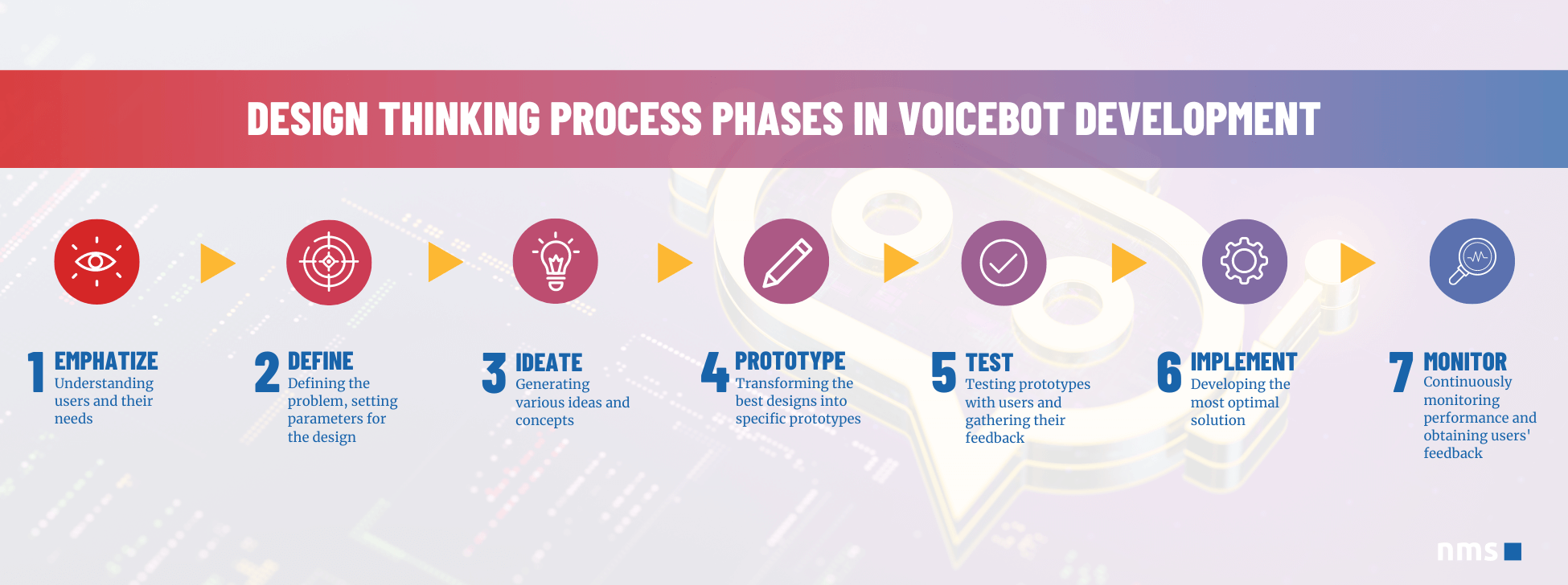The benefits of long-term communities:
How to utilize the Design Thinking Process in voicebot development
19. 7. 2023, Authors: Jana Svobodová, Vít Pavliš, Eva Waldaufová
Our Echonity insight platform is often used for developing products, services, or processes. In these cases, we like to include the Design Thinking Process in our research methodology as it involves several phases. Moreover, we have fine-tuned it to make the most out of our long-term communities thanks to which the process doesn’t end with releasing the final product but enables community members to provide inputs for further development.
What is Design Thinking?
Being a popular research approach, Design Thinking is a creative and innovative process that focuses on solving complex problems and generating new ideas. It is an approach that emphasizes the users and their needs.
Design Thinking serves to facilitate and structure the process of creating innovative solutions. It is an iterative and user-oriented approach that emphasizes understanding users, their needs, and expectations. It provides a framework and methodology for systematically approaching problem-solving and creating better user experiences.
What does the development look like in practice?
Lately, the development of chatbots or voicebots has resonated frequently in our online community, Echonity. This use case demonstrates the benefits that our platform brings to service development.
Together with the client, we defined the target group of participants that best represented the users for whom they were designing the voicebot. Selecting the right participants was truly key in this case. We started by gathering insights from community members via moderated discussions, and collecting feedback via diaries.
The development of the voicebot within the Design Thinking Process proceeded through several phases:

1. Empathize
This phase focused on gaining an understanding of users' context and perspectives. Through MODERATED DISCUSSIONS, we gained deeper insights into users' needs and expectations related to the voicebot. Respondents also shared their previous experiences with voicebots, and we identified the main problems and challenges they encounter.
2. Define
We defined the key problems the voicebot should address according to the respondents, as well as the questions it should be able to answer. We defined user personas and their needs, which served as a guide for designing and developing the voicebot. We learned from best practices or mistakes made by competitors.
3. Ideate
The goal of this phase was to find new and innovative approaches to solving the defined problem. We used brainstorming and various CREATIVE TECHNIQUES to generate and share ideas among participants, aiming to give the technical voicebot a "human touch". In MODERATED DISCUSSIONS AND SURVEYS, we addressed, for example, the voice's characteristics, gender, age, and personality the voicebot should have. How should it react, casually or seriously? Which characteristics of the voicebot align with the brand perception? We also discussed the voicebot's visual identity and name, aiming to align everything with the brand perception.
4. Prototype
When users’ ideas were explored and collected, voicebot prototypes containing basic functions and interactions were designed. These prototypes were then tested with real users to assess their functionality and identify areas for improvement.
5. Test
Users tested the voicebot prototypes design in the previous phase. They were immersed in a testing environment and went through model scenarios. They wrote down their reactions enabling us to observe how they interacted with the voicebot. In MODERATED DISCUSSIONS, they provided feedback on what worked and what didn't, and how the voicebot could be further improved. The insights and feedback were used by the client to select the most suitable prototype and refine it further.
6. Implement
The development of the final voicebot based on the most successful prototype and the feedback received from users took place. If any shortcomings were identified during testing, the team returned to previous phases to address them.
7. Monitor
For this phase, the use of DIARIES proved to be the most effective. Real interactions with the voicebot and their evaluation were continuously monitored. The insights obtained were used by the client for further iterations and improvements of the voicebot, ensuring that it meets users’ evolving needs and expectations.
Let Yourself Be Guided:
Contact: Jana Svobodová, jana.svobodova@nms.cz
